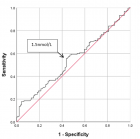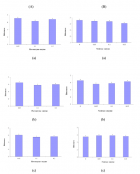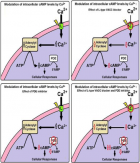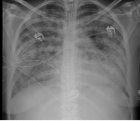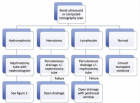Abstract
Mini Review
The use of Bacillus thuringiensis to control plant-parasitic nematodes
Yolanda Bel, Magda Galeano, Mireya Baños-Salmeron and Baltasar Escriche*
Published: 20 June, 2022 | Volume 6 - Issue 2 | Pages: 062-064
Plant-parasitic nematodes are ubiquitous in nature and cause large losses in agriculture. The current concerns regarding the use of chemical pesticides have increased the interest in new control alternatives. One of these is the one based on Bacillus thuringiensis (Bt). These Gram-positive bacteria have the ability to synthesize pesticide proteins during sporulation. Some of these proteins have nematicidal properties. Studies have shown that preparations of certain strains of Bt can prevent or slow down the infestation of phytonematodes. The expression of some Bt nematicidal genes in transgenic plants has also demonstrated their effectiveness. Bt is nowadays an effective ecological alternative for controlling plant-parasitic nematodes.
Read Full Article HTML DOI: 10.29328/journal.jpsp.1001076 Cite this Article Read Full Article PDF
References
- Marahatta SP, Wang KH, Sipes BS, Hooks CR. Effects of the integration of sunn hemp and soil solarization on plant-parasitic and free-living nematodes. J Nematol. 2012 Mar;44(1):72-9. PMID: 23482700; PMCID: PMC3593259.
- Stirling GR. Biological control of plant-parasitic nematodes: an ecological perspective, a review of progress and opportunities for further research. Davies K, Spiegel Y, editors. Biological Control of Plant-Parasitic Nematodes: Building Coherence between Microbial Ecology and Molecular Mechanisms. 2011; 1-38.
- Barker KR, Pederson GA, Windham GL. Plant and Nematode Interactions. American Society of Agronomy.
- Andres MF, Verdejo-Lucas S. Enfermedades causadas por nematdos fitoparásitos en España. Phytoma.
- Jones JT, Haegeman A, Danchin EG, Gaur HS, Helder J, Jones MG, Kikuchi T, Manzanilla-López R, Palomares-Rius JE, Wesemael WM, Perry RN. Top 10 plant-parasitic nematodes in molecular plant pathology. Mol Plant Pathol. 2013 Dec;14(9):946-61. doi: 10.1111/mpp.12057. Epub 2013 Jul 1. PMID: 23809086; PMCID: PMC6638764.
- Ali MA, Azeem F, Abbas A, Joyia FA, Li H, Dababat AA. Transgenic Strategies for Enhancement of Nematode Resistance in Plants. Front Plant Sci. 2017 May 9;8:750. doi: 10.3389/fpls.2017.00750. PMID: 28536595; PMCID: PMC5422515.
- Sikora R, Molendijk LPG, Desaeger J. Integrated nematode management and crop health: future chalenges and opportunuties. CABI. 2021; 3-10.
- van Frankenhuyzen K. Insecticidal activity of Bacillus thuringiensis crystal proteins. J Invertebr Pathol. 2009 Apr;101(1):1-16. doi: 10.1016/j.jip.2009.02.009. Epub 2009 Mar 6. PMID: 19269294.
- Palma L, Muñoz D, Berry C, Murillo J, Caballero P. Bacillus thuringiensis toxins: an overview of their biocidal activity. Toxins (Basel). 2014 Dec 11;6(12):3296-325. doi: 10.3390/toxins6123296. PMID: 25514092; PMCID: PMC4280536.
- Raymond B, Federici BA. In defence of Bacillus thuringiensis, the safest and most successful microbial insecticide available to humanity-a response to EFSA. FEMS Microbiol. Ecol. 2017;93(7).
- Sanahuja G, Banakar R, Twyman RM, Capell T, Christou P. Bacillus thuringiensis: a century of research, development and commercial applications. Plant Biotechnol J. 2011 Apr;9(3):283-300. doi: 10.1111/j.1467-7652.2011.00595.x. Epub 2011 Feb 25. PMID: 21375687.
- Sanchis V. From microbial sprays to insect-resistant transgenic plants: history of the biospesticide Bacillus thuringiensis. A review. Agron Sustain Dev. 2011;31(1):217-2
- Salehi Jouzani G, Seifinejad A, Saeedizadeh A, Nazarian A, Yousefloo M, Soheilivand S, Mousivand M, Jahangiri R, Yazdani M, Amiri RM, Akbari S. Molecular detection of nematicidal crystalliferous Bacillus thuringiensis strains of Iran and evaluation of their toxicity on free-living and plant-parasitic nematodes. Can J Microbiol. 2008 Oct;54(10):812-22. doi: 10.1139/w08-074. PMID: 18923549.
- Jouzani GS, Valijanian E, Sharafi R. Bacillus thuringiensis: a successful insecticide with new environmental features and tidings. Appl Microbiol Biotechnol. 2017 Apr;101(7):2691-2711. doi: 10.1007/s00253-017-8175-y. Epub 2017 Feb 24. PMID: 28235989.
- Ibrahim MA, Griko N, Junker M, Bulla LA. Bacillus thuringiensis: a genomics and proteomics perspective. Bioeng Bugs. 2010 Jan-Feb;1(1):31-50. doi: 10.4161/bbug.1.1.10519. PMID: 21327125; PMCID: PMC3035146.
- Adang MJ, Crickmore N, Jurat-Fuentes JL. Diversity of Bacillus thuringiensis crystal toxins and mechanism of action. In: Advances in Insect Physiology. Dhadialla TS, Gill SS, editors. Oxford: Academic Press. 2014; 39-87.
- Pardo-López L, Soberón M, Bravo A. Bacillus thuringiensis insecticidal three-domain Cry toxins: mode of action, insect resistance and consequences for crop protection. FEMS Microbiol Rev. 2013 Jan;37(1):3-22. doi: 10.1111/j.1574-6976.2012.00341.x. Epub 2012 Jun 11. PMID: 22540421.
- Prasad SSSV, Tilak K, Gollakota K. Role of Bacillus thuringiensis var. thuringiensis on the larval survivability and egg hatching of Meloidogyne spp., the causative agent of root knot disease. J Invertebr Pathol. 1972;20:377-378.
- Ruan L, Crickmore N, Peng D, Sun M. Are nematodes a missing link in the confounded ecology of the entomopathogen Bacillus thuringiensis? Trends Microbiol. 2015 Jun;23(6):341-6. doi: 10.1016/j.tim.2015.02.011. Epub 2015 Mar 25. PMID: 25818004.
- Wei JZ, Hale K, Carta L, Platzer E, Wong C, Fang SC, Aroian RV. Bacillus thuringiensis crystal proteins that target nematodes. Proc Natl Acad Sci U S A. 2003 Mar 4;100(5):2760-5. doi: 10.1073/pnas.0538072100. Epub 2003 Feb 21. PMID: 12598644; PMCID: PMC151414.
- Horak I, Engelbrecht G, van Rensburg PJJ, Claassens S. Microbial metabolomics: essential definitions and the importance of cultivation conditions for utilizing Bacillus species as bionematicides. J Appl Microbiol. 2019 Aug;127(2):326-343. doi: 10.1111/jam.14218. Epub 2019 May 23. PMID: 30739384.
- Radhakrishnan R, Hashem A, Abd Allah EF. Bacillus: A Biological Tool for Crop Improvement through Bio-Molecular Changes in Adverse Environments. Front Physiol. 2017 Sep 6;8:667. doi: 10.3389/fphys.2017.00667. PMID: 28932199; PMCID: PMC5592640.
- Azizoglu U. Bacillus thuringiensis as a Biofertilizer and Biostimulator: a Mini-Review of the Little-Known Plant Growth-Promoting Properties of Bt. Curr Microbiol. 2019 Nov;76(11):1379-1385. doi: 10.1007/s00284-019-01705-9. Epub 2019 May 17. PMID: 31101973.
- Tomita Y, Yamazaki K, Aiuchi D, Asano S-i, Koike M. Plant disease control and PGPR effects by entomopathigenic Bacillus thuringiensis. In: IOBC-WPRS Bulletin-Microbial and Nematode Control of Invertebrate Pests, IOBC-WPRS. 1502020. 170-17
- Griffitts JS, Whitacre JL, Stevens DE, Aroian RV. Bt toxin resistance from loss of a putative carbohydrate-modifying enzyme. Science. 2001 Aug 3;293(5531):860-4. doi: 10.1126/science.1062441. PMID: 11486087.
- Peng D, Wan D, Cheng C, Ye X, Sun M. Nematode-specific cadherin CDH-8 acts as a receptor for Cry5B toxin in Caenorhabditis elegans. Appl Microbiol Biotechnol. 2018 Apr;102(8):3663-3673. doi: 10.1007/s00253-018-8868-x. Epub 2018 Mar 3. PMID: 29502179.
- Wan L, Lin J, Du H, Zhang Y, Bravo A, Soberón M, Sun M, Peng D. Bacillus thuringiensis targets the host intestinal epithelial junctions for successful infection of Caenorhabditis elegans. Environ Microbiol. 2019 Mar;21(3):1086-1098. doi: 10.1111/1462-2920.14528. Epub 2019 Feb 14. PMID: 30637902.
- Yu Z, Xiong J, Zhou Q, Luo H, Hu S, Xia L, Sun M, Li L, Yu Z. The diverse nematicidal properties and biocontrol efficacy of Bacillus thuringiensis Cry6A against the root-knot nematode Meloidogyne hapla. J Invertebr Pathol. 2015 Feb;125:73-80. doi: 10.1016/j.jip.2014.12.011. Epub 2014 Dec 31. PMID: 25556591.
- Verduzco-Rosas LA, García-Suárez R, López-Tlacomulco JJ, Ibarra JE. Selection and characterization of two Bacillus thuringiensis strains showing nematicidal activity against Caenorhabditis elegans and Meloidogyne incognita. FEMS Microbiol Lett. 2021 Apr 8;368(5):fnaa186. doi: 10.1093/femsle/fnaa186. PMID: 33720297.
- Geng C, Liu Y, Li M, Tang Z, Muhammad S, Zheng J, Wan D, Peng D, Ruan L, Sun M. Dissimilar Crystal Proteins Cry5Ca1 and Cry5Da1 Synergistically Act against Meloidogyne incognita and Delay Cry5Ba-Based Nematode Resistance. Appl Environ Microbiol. 2017 Aug 31;83(18):e03505-16. doi: 10.1128/AEM.03505-16. PMID: 28710264; PMCID: PMC5583498.
- Peng D, Chai L, Wang F, Zhang F, Ruan L, Sun M. Synergistic activity between Bacillus thuringiensis Cry6Aa and Cry55Aa toxins against Meloidogyne incognita. Microb Biotechnol. 2011 Nov;4(6):794-8. doi: 10.1111/j.1751-7915.2011.00295.x. Epub 2011 Sep 19. PMID: 21923640; PMCID: PMC3815414.
- Khyami-Horani H, Al-Banna L. Efficacy of Bacillus thuringiensis jordanica against Meloidogyne javanica infecting tomato. Phytopathol. Mediterr. 2006;45(2):153-15
- Global Status of Commercialized Biotech/GM Crops in 2018: Biotech Crops Continue to Help Meet the Challenges of Increased Population and Climate Change. ISAAA Brief No. 54. ISAAA: Ithaca, NY. 2018.
- Li X-Q, Tan A, Voegtline M, Bekele S, Chen C-S, Aroian RV. Expression of Cry5B protein from Bacillus thuringiensis in plant roots confers resistance to root-knot nematode. Biol. Control. 2008;47(1):97-102.
- Cheng C, Qin J, Wu C, Lei M, Wang Y, Zhang L. Suppressing a plant-parasitic nematode with fungivorous behavior by fungal transformation of a Bt cry gene. Microb Cell Fact. 2018 Jul 23;17(1):116. doi: 10.1186/s12934-018-0960-5. PMID: 30037328; PMCID: PMC6055344.
- Li XQ, Wei JZ, Tan A, Aroian RV. Resistance to root-knot nematode in tomato roots expressing a nematicidal Bacillus thuringiensis crystal protein. Plant Biotechnol J. 2007 Jul;5(4):455-64. doi: 10.1111/j.1467-7652.2007.00257.x. Epub 2007 Apr 19. PMID: 17451491.
- Kahn TW, Duck NB, McCarville MT, Schouten LC, Schweri K, Zaitseva J, Daum J. A Bacillus thuringiensis Cry protein controls soybean cyst nematode in transgenic soybean plants. Nat Commun. 2021 Jun 7;12(1):3380. doi: 10.1038/s41467-021-23743-3. PMID: 34099714; PMCID: PMC8184815.
Figures:

Figure 1
Similar Articles
-
Impact of Calcium Phosphate Nanoparticles on Rice PlantHrishikesh Upadhyaya*,Lutfa Begum,Bishal Dey,P K Nath,S K Panda. Impact of Calcium Phosphate Nanoparticles on Rice Plant. . 2017 doi: 10.29328/journal.jpsp.1001001; 1: 001-010
-
The Effects of Pharmacological Carbonic Anhydrase Suppression on Defence Responses of Potato Leaves To Phytophthora InfestansMagdalena Arasimowicz-Jelonek*,Jolanta Floryszak-Wieczorek. The Effects of Pharmacological Carbonic Anhydrase Suppression on Defence Responses of Potato Leaves To Phytophthora Infestans. . 2017 doi: 10.29328/journal.jpsp.1001002; 1: 011-025
-
Phytochemical content of leaf and stem of Marsilea quadrifolia (L.)Rajangam Udayakumar*,Karikalan Gopalakrishnan. Phytochemical content of leaf and stem of Marsilea quadrifolia (L.). . 2017 doi: 10.29328/journal.jpsp.1001003; 1: 026-037
-
Antagonistic features displayed by Plant Growth Promoting Rhizobacteria (PGPR): A ReviewMohsin Tariq*,Muhammad Noman,Temoor Ahmed,Amir Hameed,Natasha Manzoor,Marriam Zafar. Antagonistic features displayed by Plant Growth Promoting Rhizobacteria (PGPR): A Review . . 2017 doi: 10.29328/journal.jpsp.1001004; 1: 038-043
-
Wild-type Agrobacterium rhizogenes-mediated gene transfer in plants: Agrobacterium virulence and selection of transformantsShu Wei*,Muhammad Abdullah,Ferdinand L Shamalla,Mohammad M Rana. Wild-type Agrobacterium rhizogenes-mediated gene transfer in plants: Agrobacterium virulence and selection of transformants. . 2017 doi: 10.29328/journal.jpsp.1001005; 1: 044-051
-
Effects of Vochysia haenkeana extract on the neuromuscular blockade induced by Bothrops jararaca venom on chick biventer cervicis preparation in vitroYoko Oshima-Franco*,Fernanda Dias da Silva,Natália Tribuiani,Isadora Caruso Fontana Oliveira,Regina Yuri Hashimoto Miura,Rafael S Floriano,Márcio Galdino dos Santos,Sandro Rostelato-Ferreira. Effects of Vochysia haenkeana extract on the neuromuscular blockade induced by Bothrops jararaca venom on chick biventer cervicis preparation in vitro. . 2017 doi: 10.29328/journal.jpsp.1001006; 1: 052-058
-
HBV: Genomic Structure, HBVsAg Isolation and innovative Virotherapy Initiation in the Middle EastAboul-Ata E Aboul-Ata*,Essam M Janahi,I M El-Kalamawy,Kathleen Hefferon,Amal Mahmoud. HBV: Genomic Structure, HBVsAg Isolation and innovative Virotherapy Initiation in the Middle East . . 2017 doi: 10.29328/journal.jpsp.1001007; 1: 059-061
-
Physiological impact of Zinc nanoparticle on germination of rice (Oryza sativa L) seedUpadhyaya H*,Roy H,Shome S,Tewari S,Bhattacharya MK,Panda SK. Physiological impact of Zinc nanoparticle on germination of rice (Oryza sativa L) seed . . 2017 doi: 10.29328/journal.jpsp.1001008; 1: 062-070
-
Effects of Site Factors on the Clonal Growth of Phyllostachys bambusoides f. shouzhu YiXiaohong Gan*,Lijuan Chen,Cuibin Tang,Xia Zhang. Effects of Site Factors on the Clonal Growth of Phyllostachys bambusoides f. shouzhu Yi. . 2017 doi: 10.29328/journal.jpsp.1001009; 1: 071-079
-
Evaluation of genetic diversity in germplasm of paprika (Capsicum spp.) using random amplified polymorphic DNA (RAPD) markersRueda-Puente EO*,Renganathan P,Ruíz-Alvarado C,Hernández-Montiel LG,Prasath Duraisamy. Evaluation of genetic diversity in germplasm of paprika (Capsicum spp.) using random amplified polymorphic DNA (RAPD) markers. . 2017 doi: 10.29328/journal.jpsp.1001010; 1: 080-086
Recently Viewed
-
Mapping the Psychosocial: Introducing a Standardised System to Improve Psychosocial Understanding within Mental HealthMatthew Bretton Oakes*. Mapping the Psychosocial: Introducing a Standardised System to Improve Psychosocial Understanding within Mental Health. Arch Psychiatr Ment Health. 2024: doi: 10.29328/journal.apmh.1001051; 8: 012-019
-
Human Performance Augmenting Drugs and TechnologiesR Dinesh Kumar*. Human Performance Augmenting Drugs and Technologies. J Forensic Sci Res. 2024: doi: 10.29328/journal.jfsr.1001069; 8: 089-103
-
Methodology for Studying Combustion of Solid Rocket Propellants using Artificial Neural NetworksVictor Abrukov*, Weiqiang Pang, Darya Anufrieva. Methodology for Studying Combustion of Solid Rocket Propellants using Artificial Neural Networks. Ann Adv Chem. 2024: doi: 10.29328/journal.aac.1001048; 8: 001-007
-
The bio-energy transport in the protein molecules and its experimental validations of correctnessPang Xiao-Feng*. The bio-energy transport in the protein molecules and its experimental validations of correctness. Ann Proteom Bioinform. 2018: doi: 10.29328/journal.apb.1001004; 2: 001-048
-
Laparoscopic approach for acute right iliac fossa pathology: Our experienceLuciano Onofrio*,Gianfausto Iarrobino. Laparoscopic approach for acute right iliac fossa pathology: Our experience. Arch Surg Clin Res. 2020: doi: 10.29328/journal.ascr.1001055; 4: 054-058
Most Viewed
-
Evaluation of Biostimulants Based on Recovered Protein Hydrolysates from Animal By-products as Plant Growth EnhancersH Pérez-Aguilar*, M Lacruz-Asaro, F Arán-Ais. Evaluation of Biostimulants Based on Recovered Protein Hydrolysates from Animal By-products as Plant Growth Enhancers. J Plant Sci Phytopathol. 2023 doi: 10.29328/journal.jpsp.1001104; 7: 042-047
-
Sinonasal Myxoma Extending into the Orbit in a 4-Year Old: A Case PresentationJulian A Purrinos*, Ramzi Younis. Sinonasal Myxoma Extending into the Orbit in a 4-Year Old: A Case Presentation. Arch Case Rep. 2024 doi: 10.29328/journal.acr.1001099; 8: 075-077
-
Feasibility study of magnetic sensing for detecting single-neuron action potentialsDenis Tonini,Kai Wu,Renata Saha,Jian-Ping Wang*. Feasibility study of magnetic sensing for detecting single-neuron action potentials. Ann Biomed Sci Eng. 2022 doi: 10.29328/journal.abse.1001018; 6: 019-029
-
Pediatric Dysgerminoma: Unveiling a Rare Ovarian TumorFaten Limaiem*, Khalil Saffar, Ahmed Halouani. Pediatric Dysgerminoma: Unveiling a Rare Ovarian Tumor. Arch Case Rep. 2024 doi: 10.29328/journal.acr.1001087; 8: 010-013
-
Physical activity can change the physiological and psychological circumstances during COVID-19 pandemic: A narrative reviewKhashayar Maroufi*. Physical activity can change the physiological and psychological circumstances during COVID-19 pandemic: A narrative review. J Sports Med Ther. 2021 doi: 10.29328/journal.jsmt.1001051; 6: 001-007

HSPI: We're glad you're here. Please click "create a new Query" if you are a new visitor to our website and need further information from us.
If you are already a member of our network and need to keep track of any developments regarding a question you have already submitted, click "take me to my Query."






